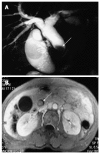Biliary tract intraductal papillary mucinous neoplasm: report of 19 cases
- PMID: 25892877
- PMCID: PMC4394088
- DOI: 10.3748/wjg.v21.i14.4261
Biliary tract intraductal papillary mucinous neoplasm: report of 19 cases
Abstract
Aim: To gain a better understanding of biliary tract intraductal papillary mucinous neoplasm (BT-IPMN).
Methods: From January 2000 to December 2013, 19 cases of BT-IPMN were retrospectively identified from a total of 343 biliary tract tumors resected in our single institution. Demographic characteristics, clinical data, pathology, surgical strategies, and long-term follow-up were analyzed.
Results: The mean age of the 19 BT-IPMN cases was 53.8 years (range: 25-74 years). The most common symptom was abdominal pain (15/19; 78.9%), followed by jaundice (7/19; 36.8%). Cholangitis was associated with most (16/19; 84.2%) of the BT-IPMN cases. Macroscopically visible mucin was detected in all 19 patients, based on original surgical reports. The most common abnormal preoperative imaging findings for BT-IPMN were bile duct dilation (19/19; 100%) and intraluminal masses (10/19; 52.6%). Thirteen (68.4%) cases involved the intrahepatic bile duct and hilum. We performed left hepatectomy in 11/19 (57.9%), right hepatectomy in 2/19 (10.5%), bile duct resection in 4/19 (21.1%), and pancreatoduodenectomy in 1/19 (5.3%) patients. One (5.3%) patient was biopsied and received a choledochojejunostomy because of multiple tumors involving the right extrahepatic and left intrahepatic bile ducts. Histology showed malignancy in 10/19 (52.6%) patients. The overall median survival was 68 mo. The benign cases showed a non-significant trend towards improved survival compared to malignant cases (68 mo vs 48 mo, P = 0.347). The patient without tumor resection died of liver failure 22 mo after palliative surgery.
Conclusion: BT-IPMN is a rare biliary entity. Complete resection of the tumor is associated with good survival, even in patients with malignant disease.
Keywords: Biliary tract; Cystic tumor; Intraductal papillary mucinous neoplasm; Mucinous tumor; Papillary tumor.
Figures




Similar articles
-
An observational and comparative study on intraductal papillary mucinous neoplasm of the biliary tract and the pancreas from a Chinese cohort.Clin Res Hepatol Gastroenterol. 2016 Apr;40(2):161-8. doi: 10.1016/j.clinre.2015.12.002. Epub 2016 Jan 25. Clin Res Hepatol Gastroenterol. 2016. PMID: 26823040
-
Gd-EOB-DTPA-enhanced magnetic resonance imaging for bile duct intraductal papillary mucinous neoplasms.World J Gastroenterol. 2015 Jul 7;21(25):7824-33. doi: 10.3748/wjg.v21.i25.7824. World J Gastroenterol. 2015. PMID: 26167082 Free PMC article.
-
A comparison between intraductal papillary neoplasms of the biliary tract (BT-IPMNs) and intraductal papillary mucinous neoplasms of the pancreas (P-IPMNs) reveals distinct clinical manifestations and outcomes.Eur J Surg Oncol. 2013 Jun;39(6):554-8. doi: 10.1016/j.ejso.2013.02.016. Epub 2013 Mar 15. Eur J Surg Oncol. 2013. PMID: 23506840
-
Mucinous Cystic Neoplasm of the Liver or Intraductal Papillary Mucinous Neoplasm of the Bile Duct? A Case Report and a Review of Literature.Ann Hepatol. 2018 May-June;17(3):519-524. doi: 10.5604/01.3001.0011.7397. Epub 2018 Apr 9. Ann Hepatol. 2018. PMID: 29735801 Review.
-
Intrahepatic biliary intraductal papillary mucinous neoplasm with gallbladder agenesis: case report.Surg Laparosc Endosc Percutan Tech. 2013 Apr;23(2):e61-4. doi: 10.1097/SLE.0b013e31824a7e6c. Surg Laparosc Endosc Percutan Tech. 2013. PMID: 23579531 Review.
Cited by
-
Green Sludge: Intraductal Papillary Mucinous Neoplasm of the Bile Duct Presenting with Intermittent Biliary Obstruction Due to Abundant Mucus.Dig Dis Sci. 2017 Aug;62(8):1897-1900. doi: 10.1007/s10620-016-4244-9. Epub 2016 Jul 16. Dig Dis Sci. 2017. PMID: 27423887 No abstract available.
-
Digital cholangioscopy in a patient with biliary tract intraductal papillary mucinous neoplasm.VideoGIE. 2019 Aug 30;4(11):517-518. doi: 10.1016/j.vgie.2019.07.007. eCollection 2019 Nov. VideoGIE. 2019. PMID: 31709346 Free PMC article. No abstract available.
-
Intraductal papillary neoplasm of the bile duct: a single-center retrospective study.J Int Med Res. 2018 Oct;46(10):4258-4268. doi: 10.1177/0300060518792800. Epub 2018 Aug 15. J Int Med Res. 2018. PMID: 30111208 Free PMC article.
-
Metachronous Intraductal Papillary Neoplasm of the Bile Duct and Intraductal Papillary Mucinous Neoplasm of the Pancreas in a Patient Diagnosed With Mucinous Adenocarcinoma.ACG Case Rep J. 2019 Mar 1;6(2):e00023. doi: 10.14309/crj.0000000000000023. eCollection 2019 Feb. ACG Case Rep J. 2019. PMID: 31616721 Free PMC article.
-
Uncommon neoplasms of the biliary tract: radiological findings.Br J Radiol. 2017 Oct;90(1078):20160561. doi: 10.1259/bjr.20160561. Epub 2017 Jul 21. Br J Radiol. 2017. PMID: 28731820 Free PMC article.
References
-
- Sclabas GM, Barton JG, Smyrk TC, Barrett DA, Khan S, Kendrick ML, Reid-Lombardo KM, Donohue JH, Nagorney DM, Que FG. Frequency of subtypes of biliary intraductal papillary mucinous neoplasm and their MUC1, MUC2, and DPC4 expression patterns differ from pancreatic intraductal papillary mucinous neoplasm. J Am Coll Surg. 2012;214:27–32. - PubMed
-
- Zen Y, Fujii T, Itatsu K, Nakamura K, Minato H, Kasashima S, Kurumaya H, Katayanagi K, Kawashima A, Masuda S, et al. Biliary papillary tumors share pathological features with intraductal papillary mucinous neoplasm of the pancreas. Hepatology. 2006;44:1333–1343. - PubMed
-
- Kim HJ, Kim MH, Lee SK, Yoo KS, Park ET, Lim BC, Park HJ, Myung SJ, Seo DW, Min YI. Mucin-hypersecreting bile duct tumor characterized by a striking homology with an intraductal papillary mucinous tumor (IPMT) of the pancreas. Endoscopy. 2000;32:389–393. - PubMed
-
- Oshikiri T, Kashimura N, Katanuma A, Maguchi H, Shinohara T, Shimizu M, Kondo S, Katoh H. Mucin-secreting bile duct adenoma--clinicopathological resemblance to intraductal papillary mucinous tumor of the pancreas. Dig Surg. 2002;19:324–327. - PubMed
Publication types
MeSH terms
LinkOut - more resources
Full Text Sources
Other Literature Sources

